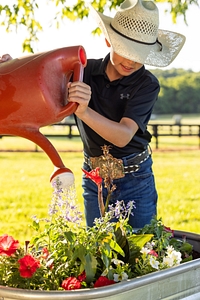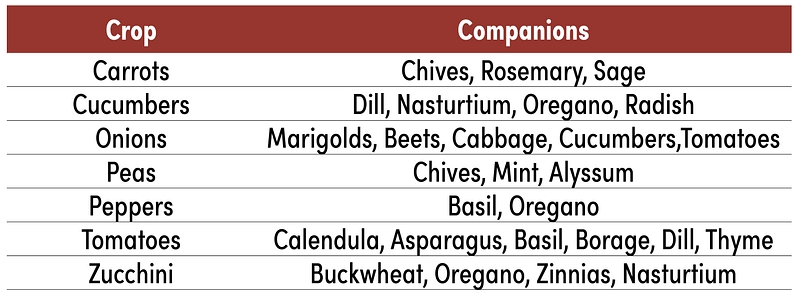Container gardening is an excellent way to grow vegetables and flowers, even if you have limited space. While almost any vegetable can thrive in a container, some are better suited than others. To ensure your container garden flourishes, here are some essential tips and tricks to get you started.
Choosing the Right Container

Selecting the appropriate container is one of the most critical steps in container gardening. Here’s what you need to consider:
- Size Matters: Always opt for the largest container you can accommodate. Larger containers:
- Retain more moisture, reducing the frequency of watering.
- Help roots stay cooler during the summer heat.
- Drainage is Key:
- Ensure your container has adequate drainage holes to prevent root rot.
- If the container lacks holes, you can often drill them yourself.

Holes can be drilled in the bottom of Behlen Country stock tanks to allow for proper drainage.
The Right Soil for Success
The soil you use can make or break your container garden:
- Use Potting Mix: Regular garden soil compacts easily in containers, leading to poor drainage and restricted root growth. Opt for soil designed for containers.
- Fertilization: Different plants have varying nutrient needs. For example, heavy feeders like onions may require frequent fertilizer applications during the growing season.
- Mulching: Apply mulch as a top dressing to aid in moisture retention and reduce evaporation.
Pairing Compatible Plants
When planting multiple species in a single container, consider their compatibility:
- Light, Water, and Fertilizer Needs: Group plants with similar requirements.
- Growth Habits: Avoid pairing aggressive growers with slower-growing plants to prevent overcrowding and competition.
Watering Your Containers

Consistent watering is essential for healthy plants. Here are some options:
- Hand Watering:
- Labor-intensive, especially in hot weather when plants may need water multiple times a day.
- Automated Drip Irrigation:
- Requires initial setup but reduces daily labor.
- Needs regular monitoring for blockages or leaks.
- Self-Watering Containers:
- Pre-made self-watering containers are available, or you can DIY one following online tutorials.

Shallow Tanks and Planters
Our shallow Behlen Country Stock Tanks are best suited for shallow rooted plants and vegetables such as basil, green beans, beets, kale lettuce, peas, parsley, radishes and strawberries.

Tall Tanks and Planters
Medium rooted vegetables like carrots, cucumbers, peppers, potatoes, compact tomatoes, and sweet potatoes are more appropriate for our taller Behlen Country stock tanks.

Raised Garden Beds or Bottomless Planters
For deeply rooted vegetables a raised garden bed or Behlen Country bottomless planter will be most appropriate. These types of plants include melons, pumpkins, winter squash, and indeterminate tomatoes.
When to Consider Raised Bed Gardening
As you gain experience or space, you might decide to transition to raised bed gardening. Raised beds share many principles with container gardening but offer additional flexibility. It is ideal for larger or deeply rooted vegetables and allows you to grow multiple plants in the same bed. Raised beds also provide more room for expansion, making them a practical choice for gardeners looking to scale up their efforts.
Tips for Successful Raised Bed Gardens
Location: Most vegetables are sun-loving plants and require at least 6–8 hours of sunlight daily. Ensure the location of your beds isn’t shaded during the day. Additionally, protect the beds from extreme winds if your area is prone to such conditions. Water access is another critical consideration. Whether you plan to water with a sprinkler, garden hose, or drip line system, ensure a water source is nearby or plan for necessary infrastructure. Future-proof your garden by choosing a location that allows for expansion or additional beds. Lastly, consider convenience—place the beds close to where you’ll store your harvest, such as your kitchen or root cellar.

Soil: One of the biggest benefits of raised bed gardening is the ability to control the planting medium. Raised beds make it easier to amend the soil to suit your plants’ needs. When filling your beds, start by calculating how much soil you’ll need. It’s essential to fill the beds completely initially, as soil will settle over time. Use a mix that offers good drainage and is rich in nutrients, such as pre-bagged raised garden mix available at most garden centers or farm and ranch stores. Bulk soil from garden centers is also an option, and staff can recommend the best composition for your plants. For those who prefer a DIY approach, research or consult experienced gardeners to ensure the right combination of ingredients for healthy plant growth. To the right is a chart depicting the cubic feet needed to fill Behlen Country Bottomless Planters.
Plan for Multiple Harvests: Raised bed soil warms up faster than in-ground gardens, extending the growing season. This allows for multiple harvests through succession planting. Focus on crops with shorter growing periods—information typically found on seed packets or plant tags. Use a calendar to plan your growing season efficiently and maximize your garden space.
Companion Planting: Companion planting provides numerous advantages, including pest deterrence. Plant vegetables near companions that naturally repel pests for a chemical-free way to protect your harvest. Conversely, certain plants attract beneficial insects, improving pollination and boosting yields. Companion planting can also enhance soil health by replenishing nutrients used by previous crops and improving aeration. Additionally, densely planted beds suppress weed growth by shading out weed seedlings. Below is a list of companion plants for common garden vegetables.

Conclusion
Container and raised bed gardening are versatile, rewarding methods to grow your favorite vegetables and plants. By selecting the right containers or constructing efficient raised beds, using appropriate soil, and establishing proper watering techniques, you can enjoy a thriving garden regardless of space constraints. Start small, learn as you go, and watch your green thumb grow!

